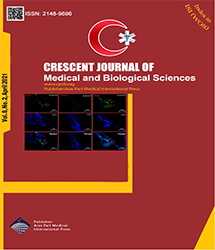| Short Communication | |
| The 50 Hertz Extremely Low-Frequency Electromagnetic and the T-helper Balance | |
| Bita Hazhir Karzar1, Parisa Lotfinejad1,2, Masumeh Zamanlu3, Afshin Khaki Amir4, Mohammad Amini2, Ali Sheikh Olya Lavasani5, Badrossadat Rahnama1 | |
| 1Department of Immunology, Tabriz University of Medical Sciences, Tabriz, Iran 2Immunology Research Center, Tabriz University of Medical Sciences, Tabriz, Iran 3Neurosciences Research Center, Tabriz University of Medical Sciences, Tabriz, Iran 4Associate Professor, Department of Anatomy and Embryology, Tabriz University of Medical Science, Tabriz, Iran 5Faculty of Veterinary Medicine, Tabriz Azad University, Tabriz, Iran |
|
|
CJMB 2021; 8: 151-155 Viewed : 3459 times Downloaded : 2356 times. Keywords : Electromagnetic radiation, Immunity, IL-4, INF-γ |
|
| Full Text(PDF) | Related Articles | |
| Abstract | |
Objectives: Electromagnetic fields (EMFs) are developing in scientific areas while biologic and immunologic effects have been proven in many studies. The purpose of the present study was to determine the effect of 50 Hz EMFs in the manner of the whole body exposure on the T-helper balance (Th1/Th2) in rats. Materials and Methods: This experimental research evaluated the impact of the EMF on T-helper balance, including 30 rats that were randomly divided into 3 groups. The control group and experimental groups were exposed to 50 Hz EMF with the intensity of 0.5 mT for one and two month(s), respectively. At the end of the exposure period, blood samples were collected from the left ventricle of the hearts of the rats and the serum levels of interleukin 4 (IL-4) and interferon gamma (INF-γ) were measured by the enzyme-linked immunosorbent assay and compared in all three groups. Results: The level of IL-4 and INF-γ showed a notable change (P = 0.032) during one month of EMF exposure, indicating a shift of T-helper balance toward the Th2 arm, meaning more strong allergic reactions and weaker immune responses against tumors and many other diseases. After 2 months, the levels of cytokines and the balance of the T-helper came close to the baseline (the control group samples), representing the adaptive trends of T-helper balance in longer exposures. Conclusions: The results of the present research revealed that EMFs produced important changes in IL-4 and INF-γ levels and affected the T-helper balance shift toward the Th2 arm, implying stronger allergic reactions and weaker defense against tumor and various other diseases. However, understanding the true nature of these changes and their actual health effects requires further studies. |
Cite By, Google Scholar
Google Scholar
PubMed
Online Submission System
 CJMB ENDNOTE ® Style
CJMB ENDNOTE ® Style
 Tutorials
Tutorials
 Publication Charge
Medical and Biological Research Center
About Journal
Publication Charge
Medical and Biological Research Center
About Journal
Aras Part Medical International Press Editor-in-Chief
Arash Khaki
Deputy Editor
Zafer Akan


















